Indian Army: weapons, equipment
This is a collection of articles archived for the excellence of their content. |
Contents[hide] |
Guns, for artillery
Army gets first batch of Dhanush
P Naveen, Siddharth Pandey, April 8, 2019: The Times of India
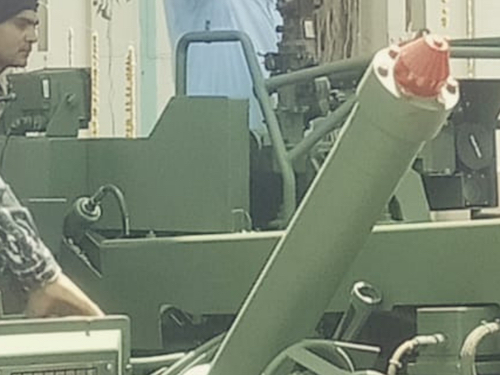
From: P Naveen, Siddharth Pandey, April 8, 2019: The Times of India
The Indian Army received its first batch of artillery guns 'desi Bofors' in Jabalpur. It will be deployed along India’s borders with Pakistan and China.
The Dhanush, which has a calibre of 155x45mm, is the first ever indigenous artillery gun of this calibre. In army parlance, it is classified as 'medium artillery'. The army’s artillery arm has 'medium regiments' that consist of guns of this calibre and of 130mm calibre. The Bofors, which had played a crucial role in targeting Pakistani military positions during the 1999 Kargil War, and similarly has a 155mm calibre is part of such regiments.
"Dhanush gun has emerged as a reliable and robust gun system at par with the latest in the world and will increase the fire power of the Indian artillery manifold. It is truly “Make in India” marvel," said officials.
The 155mm x 45 Cal FH Gun ‘DHANUSH’ is a new generation towed artillery gun with major upgraded features over the existing 155/39 cal. FH 77 B02 gun. Indigenization to the extent of approx. 81 per cent, has already been achieved. By the end of 2019, the indigenisation level will go up to 91 per cent.
On February 18, OFB had received the bulk production clearance of manufacturing of 114 guns. GCF has handed over 6 Dhanush guns for issuance to Indian Army.
DGOF & Chairman, Ordnance Factory Board (OFB) handed over the first batch of 'Dhanush’ to Central Ordnance Depot (COD), Jabalpur.
The artillery guns were handed over to the army at a formal function organised in GCF, Jabalpur.
Saurabh Kumar, IOFS, DGOF & Chairman flagged off the first batch from GCF Jabalpur to Indian Army (JOD).
Senior dignitaries from armed forces Lt Gen P K Shrivastava, PVSM, AVSM, VSM, DG Artillery & Col Comdt, Lt Gen R S Salaria, VSM, Comdt, SOA, Maj Gen Manmeet Singh, MG Arty HQ Western Command, Controller CQA(W), Commandant JOD, WDET Programme coordinator and his team were present.
Gatling guns
As in 2024
Shishir Arya, February 5, 2024: The Times of India
NAGPUR: Finding a Gatling isn’t easy, a functioning one even tougher. World’s first rapid-firing multiple-barrel machine gun, invented way back in 1862 by an American doctor, was declared obsolete by US army in 1911. Lighter, even deadlier machine guns were invented. Those Gatlings that survived being melted down became collectors’ items.
Less than 20 authentic Gatlings survive, according to Gunmagwarehouse.com.
Only one is still functional. And it’s in India, cared for by Indian Army. In 1986, GOI had turned down an American govt request to sell the Gatling, for any price, say Army officers. Last Friday, it was on display in Nagpur’s Mankapur sports stadium, a display item in the ‘Shourya Sandhya’ event. Army chief Manoj Pande was in attendance.Jabalpur’s ordnance corps museum is this Gatling’s home, where it is cared for so well that its mechanical parts all work, and it can, just as other Gatlings did in the late 19th and early 20th century, fire hundreds of rounds (.45 calibre bullets) – but not at the pull of a trigger.
When not on show, Gatling kept under heavy security
Unlike its later cousins, Gatlings were hand-cranked. As army personnel at the Nagpur stadium explained to TOI, the machine gun has 10 barrels and 10 breech blocks.
Every time a gunner revolves the shaft to a 7 o’clock position, bullets are fired in rapid succession from a foot-long magazine. World’s only Gatling that can still rain hellfire has only rare outings, understandably so given it’s a high maintenance vintage gun.
Sometime back it had been displayed in Lucknow in an army event. When not wowing spectators, the gun is kept under heavy security, Periodically, the Gatling’s machine parts get jammed, as happens in any vintage machine.
Army personnel do the overhauling, especially before the gun is put on display.
Interestingly, Jabalpur’s ordnance corps museum boasts of weapons of older vintage than the Gatling. On display at the Nagpur event were 15th century muzzle-loading muskets, a 17th century gun and US Maxim guns (invented in 1880s, these were world’s first fully automatic machine guns).
But the Gatling is clearly the star – being one of a kind does that.
Guns, small
2017: long way from modernisation
Rajat Pandit, Small arms still giving infantry jitters, October 16, 2017: The Times of India
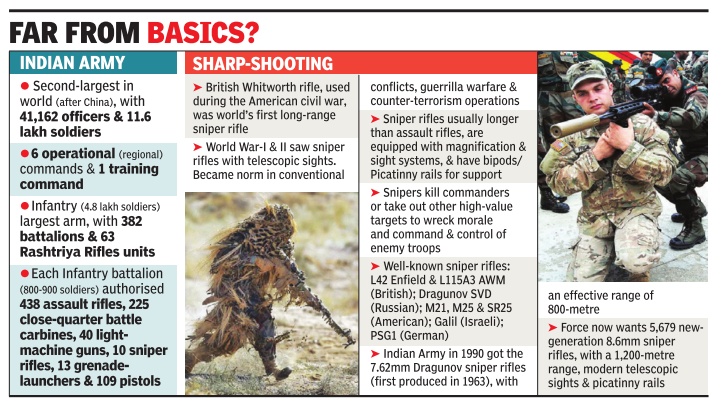
From: Rajat Pandit, Small arms still giving infantry jitters, October 16, 2017: The Times of India
Issue Figures At Meet of Army Commanders
Indian Army's foot soldiers are still nowhere close to getting basic modern infantry weapons, ranging from assault rifles and sniper guns to light machine guns and close-quarter battle carbines, after a decade of acquisition projects from abroad being repeatedly scrapped as well as failure of indigenous options to pass muster till now.
The huge delays in the induction of `small arms' for infantry battalions figured in the Army commanders' conference last week, with Gen Bipin Rawat telling his senior lieutenant generals that “our approach to procurement process needs to be balanced with focus at the right places“.
Though plans are on track to plug major operational gaps, `small arms' remain a big worry . As per overall plans, the 12-lakh strong Army needs 8,18,500 new-generation assault rifles, 4,18,300 close-quarter battle (CQB) carbines, 43,700 light machine guns and 5,679 sniper rifles. But the induction plans, which are supposed to include direct purchase of an initial number of weapons from a foreign vendor followed by largescale indigenous production with technology transfer, have failed to materialise so far.
In September 2016, the Army was forced to re-launch its global hunt for new-generation 7.62 mm x 51 mm assault rifles to replace the glitchprone 5.56 mm INSAS (Indian small arms system) rifles after similar bids over the last decade were scrapped.
Sources said the technical parameters or GSQRs (general staff qualitative requirements) for the new assault rifles, with an effective range of 500 metres, have now been finalised. “The case will now be moved for the defence min istry's approval under the `Buy & Make (Indian)' model before the formal tender or RFP (request for proposal) is floated,“ said a source.
Similarly , the procurement case for 5.56 x 45 mm CQB carbines, with an effective 200metres range, was re-launched recently after the earlier one was scrapped last year. The defence ministry had junked the earlier case, dating back to 2006, on the ground that it had become “a resultant single vendor situation“. The story of the 7.62 mm x 51mm caliber light machine guns is similar, with the Army back to square one after a long-winded procurement process. The defence ministry in August “retracted“ the tender because only IWI was left in the fray after protracted field trials from December 2015 to February 2017.
Helicopters
Army, not IAF, to get Apache helicopters/ 2017
The Army will now finally get its own heavyduty attack helicopters after a bitter tussle with the IAF over the last several years.The defence ministry cleared the acquisition of six Apache attack helicopters, armed with Hellfire and Stinger missiles, and spares and maintenance package at a cost of Rs 4,168 crore.
The 1.3-million-strong Army had earlier sought the government's nod for acquisition of 11 Apache helicopters from the US as “a follow-on contract“ to the Rs 13,952 crore deal inked for 22 such choppers for the IAF in September 2015, as was reported by TOI.
Even after stiff opposition from IAF, the Arun Jaitley-led defence acquisitions council (DAC) on Thursday cleared the Army's whittled down proposal for six AH-64E Apache helicopters, which are manufactured by Boeing.
The DAC also approved a Rs 490-crore purchase of Zorya gas-turbine engine sets from Ukraine for two of the Grigorivich-class frigates being built in Russia. During the Modi-Putin summit in Goa last year, India had agreed to purchase four 4,000-tonne Grigorivich-class guidedmissile stealth frigates at $4 billion from Russia.
While two of these frigates are lying half-constructed at the Russian Yantar shipyard due to a cash-crunch and bilateral problems between Russia and Ukraine, the other two will be built in the Goa shipyard. India will now acquire the Zorya gas-turbine engines from Ukraine and then ship them to Russia for the first two frigates.
As earlier reported by TOI, the deal for the frigates is linked to India's quest to lease a second nuclear-powered submarine (the first INS Chakra came in 2012) for around $1.5 billion from Russia.
As for the Apaches, the Army for long has been pushing for three squadrons of attack helicopters, among other choppers, for its three primary “strike“ corps geared for rapid armoured thrusts into enemy territory . The Army believes it should have “full command and control“ over “tactical air assets“ for rapid deployment along with its strike corps, while the IAF should concentrate on its “larger strategic role“. As of now, IAF's two existing but ageing squadrons of Russian-origin Mi-2535 attack helicopters are supposed to play that role. As per the earlier contract, the 22 Apaches will be delivered to IAF from July 2019 onwards, along with 812 AGM-114L-3 Hellfire Longbow missiles, 542 AGM-114R-3 Hellfire-II missiles, 245 Stinger Block I-92H missiles and 12 AN APG-78 fire-control radars.
The then UPA government had ruled that the first 22 Apaches would go to IAF. But it also held “future“ procurements of attack helicopters would be for the Army , granting “in principle approval“ to its case for raising three squadrons (13 choppers each) for the strike formations-1 Corps (Mathura), 2 Corps (Ambala) and 21 Corps (Bhopal).
Howitzers
M-777 ultralight howitzers/ 2017
Rajat Pandit, Bofors jinx breaks: 155mm artillery guns land today, May 18, 2017: The Times of India
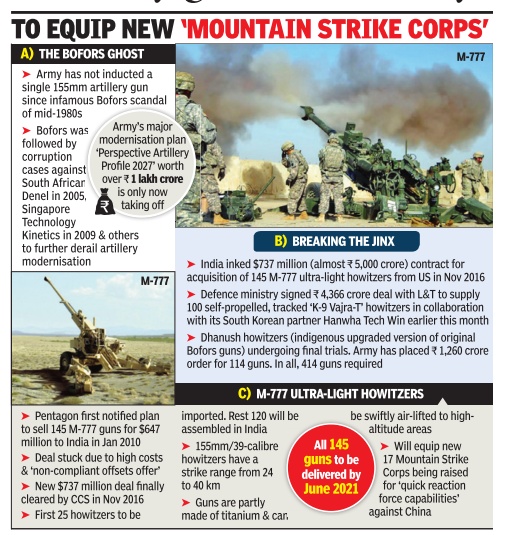
India has now exorcised the ominous Bofors ghost haunting its artillery modernisation plans for the last 30 years. In the first modern 155mm artillery guns to be inducted by the Army since the 1980s, two of the 145 M-777 ultralight howitzers ordered from the US will touch down.
Defence sources said the two howitzers, which will come in a chartered aircraft from the UK, will be taken to the Pokhran ranges for testing and “compilation of the firing tables“ for subsequent use. “The firing tables, with the guns being tested for different kinds of Indian ammunition with bimodular charges, will take some time to be formulated,“ said a source.
The delivery schedule for the air-mobile howitzers, being acquired under a $737 million deal inked with the US in a government-to-government deal, will quicken from March 2019 onwards. “Five guns will then be delivered every month till all 145 are inducted by June 2021. While the first 25 guns will be imported, the remaining 120 will be assembled in India with artillery-manufacturer BAE Systems selecting Mahindra as its business partner here,“ he added.
The arrival of the M-777 guns, which are primarily meant for the front with China, comes soon after the government also inked a Rs 4,366 crore contract with engineering conglomerate L&T for the supply of 100 self-propelled howitzers in collaboration with its South Korean partner Hanwha Tech Win. These 155mm52calibre tracked guns called K-9 Vajra-T, in turn, are to be delivered within 42 months, as earlier reported by TOI.
The Army has not inducted a single 155mm artillery gun since the Bofors scandal brought down the Rajiv Gandhi government, and derailed all plans for technology transfer and indigenous manufacture.
Subsequent scandals revolving around other global artillery manufacturers (see graphic) , like South African Denel and Singapore Technology Kinetics, further punched gaping holes in the Army's long-range, highvolume firepower. Interestingly , the original Swedish Bofors company is now owned by BAE Systems.
2018/ 155mm howitzers (+self-propelled guns)
30 yrs after Bofors, Army gets big guns, November 10, 2018: The Times of India
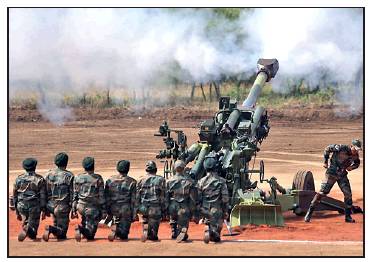
From: 30 yrs after Bofors, Army gets big guns, November 10, 2018: The Times of India
Receives Advanced 155mm Howitzers
The big guns are finally booming in India again. The Army officially inducted its first advanced 155mm howitzers for high-volume fire-power after a gap of three decades, finally exorcising the Bofors ghost that stymied all its artillery modernisation plans since the late-1980s.
Three M-777 ultra-light howitzers from the US and ten K-9 Vajra tracked selfpropelled guns from South Korea were symbolically handed over to the Army, after extensive testing and “compilation of firing tables” spread over some months, at the Deolali field firing ranges in Maharashtra.
The ceremony, attended by defence minister Nirmala Sitharaman, her junior minister Dr Subhash Bhamre and Army chief General Bipin Rawat among others, also witnessed the induction of 6x6 field artillery tractors developed by Ashok Leyland to replace the ageing fleet of gun-towing vehicles.
“These state-of-the-art gun systems are being inducted almost 30 years after the Bofors guns were inducted. The Army will get many more such systems over the next few years,” said Sitharaman. While the M-777 howitzers have a strike range of 30-km, the K-9 guns can target enemy positions 28-38 km away.
India had inked the $737 million (over Rs 5,000 crore) contract for acquisition of 145 M-777 howitzers from the US in a government-togovernment deal after it was cleared by the Cabinet Committee on Security in November 2016, as was first reported by TOI.
All 145 of these air-mobile 155m/39-calibre howitzers are slated for induction by August 2021, with five guns to be delivered every month from August 2019 onwards. While the first 25 guns will be imported, the rest 120 will be assembled in India with artillery-manufacturer BAE Systems selecting Mahindra Defence as its business partner here.
The Rs 4,366 crore deal for the100155mm/52-calibre K-9 guns, in turn, was signed with Larsen & Toubro and its South Korean partner Hanwha Tech Win last year. Ninety of the guns will be largely manufactured in India, with some major assemblies coming from South Korea, with the first 40 slated for delivery by November 2019 and the rest 50 by November 2020.
The13-lakh strong Army could not induct a single 155mm artillery gun since the Bofors scandal brought down the Rajiv Gandhi government, and derailed all plans for technology transfer and indigenous manufacture.
Subsequent scandals revolving around other global artillery manufacturers, like South African Denel in 2005 and Singapore Technology Kinetic’s in 2009, further derailed the Army’s artillery modernisation plans. Interestingly, the original Swedish Bofors company is now owned by BAE Systems.
The Army has been demanding ultra-light howitzers like the M-777s for over 15 years as part of the plan to build robust conventional deterrence against China. Weighing just over 4-tonne due to the use of titanium, the M-777 can swiftly be airlifted by helicopters and aircraft to high-altitudes areas up to 16,000-feet in Ladakh and Arunachal Pradesh along the 4,057-km Line of Actual Control with China.
Missiles
2019/Spike anti-tank guided missiles
Rajat Pandit . Oct 4, 2019: The Times of India

From: Rajat Pandit . Oct 4, 2019: The Times of India
Indian infantry soldiers finally have a new weapon to destroy advancing enemy tanks on the western front with Pakistan. The Army has begun to induct a limited number of Israeli Spike anti-tank guided missiles (ATGMs) to meet immediate operational requirements till indigenous man-portable “tank killers” being developed by DRDO are ready for induction.
Sources said on Thursday that the “first lot” of the 210 Spike missiles, with a dozen launchers, “arrived in India about 10 days ago” as part of the “Army vice-chief ’s emergency procurement powers” exercised by the force amid the ongoing heightened tensions with Pakistan.
The Army moved to buy the initial amount of the fireand-forget Spike ATGMs, which have a strike range of up to 4-km, for around Rs 280 crore after the Jaish-e-Muhammed training facility in Pakistan was bombed by Indian Mirage-2000 fighters on February 26. “The order will be repeated if the man-portable ATGM being developed by DRDO is not ready by next year. We don’t want to be slowed down any longer in plugging our critical operational deficiencies by DRDO,” said an Army source.
DRDO, however, is quite confident about offering its MP-ATGM for “user trials” in 2020 after having conducted three successful trials of the weapon system at the Kurnool range in Andhra early last month. “The third-generation MP-ATGM, which has stateof-the-art infrared imaging seekers along with advanced avionics, hit the targets mimicking operational tanks in topattack mode to destroy them with precision at 2.5-km range,” said a DRDO official.
Whether it’s indigenous or Israeli man-portable “tank killers”, the fact remains that the 13-lakh strong Army has an alarming shortage of over 50% in its “authorised holding” of different kinds of shoulder-, vehicle- and helicopterlaunched ATGMs, which are crucial to halt advancing enemy tanks in the plains, as well as “bunker-bursting” across the volatile Line of Control with Pakistan.
The Army’s existing second-generation Milan-2T (2-km range) and Konkurs (4-km) ATGMs, produced by defence PSU Bharat Dynamics under licence from French and Russian firms, do not have night-fighting capabilities.
Musical instruments
2018: British Band Instrument Company gets ₹31.5cr order
A small British company, with just six employees, has struck a £3.5 million (about Rs 31.5 crore) trade deal to sell musical instruments to the Indian Army.
The London-based British Band Instrument Company is sending 1,500 instruments to military bands in India via sea freight through Mumbai. There are two contracts: one to send bagpipes to 26 Indian military bands and one to send drums, cornets, trombones, tubas, flutes, clarinets, French Horns and euphoniums to 47 regimental centres.
“It’s one of the biggest contracts we’ve had,” said Alun Hughes who founded the company 10 years ago. “They want to use the same instruments they’ve historically been supplied. We provide the same quality and specification as Boosey & Hawkes. These instruments are not manufactured in India to my knowledge.”
He said Indian military bands are “almost the same as British military bands”. “It’s a Raj legacy but though people think bagpipes are Scottish, they actually emanate from Middle East (West Asia) and Indian subcontinent,” he said. Hughes has been manufacturing and repairing instruments for decades. He recalls how in the 1950s a colleague at Boosey & Hawkes, where he then worked, supplied military band instruments to maharajas. “He’d be paid in gold bullion, take it to Dubai, convert it into tolas and turn that into currency to send back to the United Kingdom.”
Hughes now manufactures under licence with the Boosey & Hawkes brand name and supplies 70 countries, many of them Commonwealth nations. A department for international Trade spokesman said: “The UK currently exports £7.9 billion of goods and services to India each year… deals like this show clear demand for our… products.”
Rifles
2016
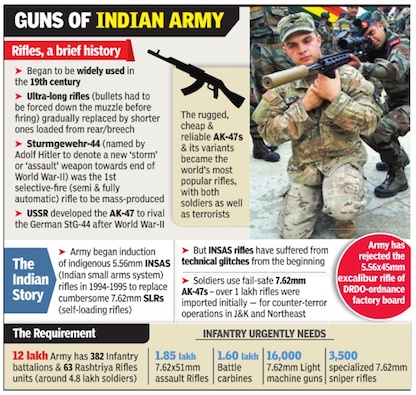
Rajat Pandit, Sep 28 2016: The Times of India
See graphic:
The use of rifles in the India Army: brief history and requirements as in 2016
Unmanned Air Vehicles
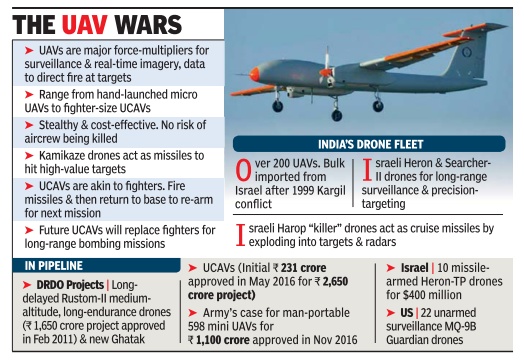
See graphic:
Unmanned Air Vehicles in India